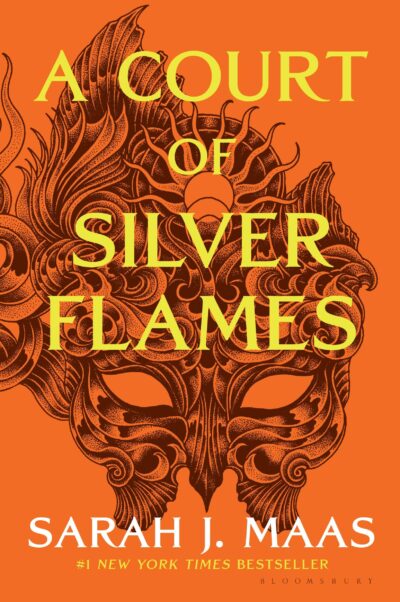
A Court of Silver Flames
Chapter Nine
by J, Maas, SarahNesta enters a small shop in search of warmer clothing, noting its polished pine floors and neatly displayed garments. She encounters Emerie, a striking dark-haired female with scars on her wings, who offers practical assistance without acknowledging Nesta’s fame. Their conversation reveals Emerie’s blunt yet kind demeanor, as she inquires about Nesta’s needs and suggests fleece-lined leathers to combat the cold. Nesta, initially guarded, finds herself drawn to Emerie’s straightforwardness, a contrast to the judgment she often faces.
Emerie shares her traumatic past, explaining her clipped wings as a result of her father’s oppressive beliefs. Nesta expresses sympathy, but Emerie dismisses it, focusing instead on her present life running the shop. The discussion shifts to Nesta’s financial constraints, prompting her to admit she’s been cut off from Rhysand’s support. Emerie, undeterred, offers to help regardless, displaying a resilience that resonates with Nesta. Their interaction hints at a budding mutual respect, underscored by Emerie’s admiration for Nesta’s role in killing the King of Hybern.
Nesta’s internal conflict is evident as she grapples with her reputation and self-perception. Emerie’s approval unsettles her, as she’s accustomed to fear or awe from others. The chapter highlights Nesta’s isolation and her tentative steps toward connection, even as she maintains a defensive exterior. The townspeople’s wary reactions to her departure reinforce her sense of alienation, yet Emerie’s kindness lingers as a rare positive encounter.
The chapter closes with Nesta returning to her duties, still chilled but perhaps slightly warmed by Emerie’s unexpected camaraderie. Their brief exchange plants the seeds of a potential friendship, offering Nesta a glimpse of understanding and solidarity. The narrative underscores themes of resilience, trauma, and the slow process of healing, as both women navigate their pasts and present challenges with quiet strength.
FAQs
1. How does the setting of Emerie’s shop reflect her character and background?
Answer:
The shop’s fresh pine floors and polished counter suggest Emerie takes pride in her work and maintains order in her life, contrasting with the trauma of her clipped wings. The organized display of clothing and her practical approach to Nesta’s request for warmer leathers demonstrate her resilience and adaptability after her forced grounding. The shop becomes a symbol of her independence from her “traditional” father’s oppression, as she’s created a thriving business despite her physical limitations (pg. 107-108). The warm, welcoming atmosphere also hints at her capacity for kindness beneath her frank exterior.2. Analyze the significance of the interaction where Emerie reveals she knows Nesta’s identity.
Answer:
This moment (pg. 110) subverts Nesta’s expectations—rather than judging her negatively as others do, Emerie approves of Nesta’s most violent act (killing Hybern’s king). Their mutual bluntness creates an immediate bond, with Emerie’s “Good” repeated twice emphasizing genuine respect. This contrasts with townspeople who gawk or hide children from Nesta later in the chapter. The interaction suggests Emerie values strength in females who defy expectations, seeing Nesta as a kindred spirit rather than a monster. It also marks a rare moment where Nesta doesn’t feel defensive about her past actions.3. What does the chapter reveal about societal attitudes toward female warriors in the Night Court?
Answer:
Through Emerie’s comment about “proud fools” (pg. 108) and her clipped wings backstory (pg. 109), we see deep-seated gender biases. Male warriors refuse to admit leathers are cold to maintain a tough image, while Emerie’s father physically restrained her for rejecting domestic roles. Nesta’s presence as a non-warrior observing training further challenges norms. The townspeople’s reactions to Nesta (pg. 110) also reflect discomfort with females who break conventions, whether through violence (Nesta) or independence (Emerie). The chapter critiques a society that simultaneously relies on female strength (Feyre, Amren) yet fears it in unconventional forms.4. How does the theme of bodily autonomy develop in this chapter?
Answer:
Bodily autonomy emerges through three layers: Emerie’s clipped wings represent forced physical limitation (pg. 109), Nesta’s lack of financial control shows economic dependence (pg. 109-110), and the townspeople’s reactions demonstrate social constraints on behavior. Emerie’s matter-of-fact acceptance of her wings contrasts with Nesta’s shame about her financial cut-off, showing different coping mechanisms. The potential fleece-lined leathers become symbolic—Emerie seeks to give Nesta comfort in her body during training, something she was denied herself. This builds toward later themes of female solidarity in reclaiming agency.
Quotes
1. “The warriors are all such proud fools that they never complain about the leathers being cold. They claim they keep them perfectly warm.”
This quote introduces Emerie’s sharp wit and establishes an immediate camaraderie with Nesta through their shared skepticism of male bravado. It reveals the shopkeeper’s no-nonsense personality while subtly critiquing gender norms in their society.
2. “My wings were clipped. My father was a … traditional male. He believed females should serve their families and be confined to their homes. I disagreed. He won, in the end.”
Emerie’s blunt confession about her traumatic past creates a powerful moment of vulnerability and establishes thematic parallels with Nesta’s own struggles. The clipped wings serve as a potent metaphor for patriarchal oppression and personal resilience.
3. “I know. You killed the King of Hybern. Good. Good.”
This pivotal exchange marks the first genuine approval Nesta has received for her actions in the war. Emerie’s emphatic repetition of “Good” and the steel in her eyes suggest she represents a new type of ally for Nesta - one who values strength over propriety.
4. “You’re right to hide your children from me. I am the monster you fear.”
Nesta’s internal monologue reveals her deep self-loathing and how she’s internalized society’s judgment of her. This thought showcases her complex psychology and the novel’s exploration of trauma and self-perception.
